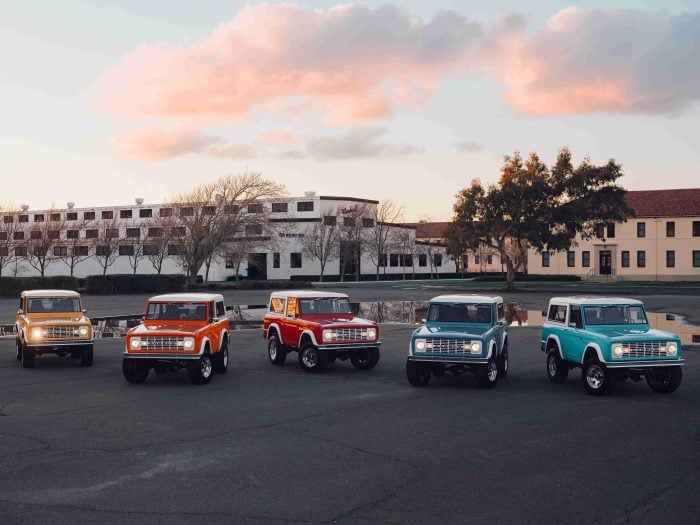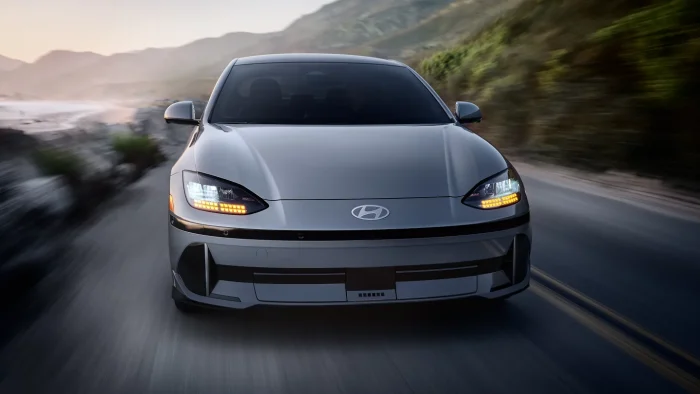Cars were ultimately created for a purpose: to get you from a place you didn’t need to be, to a place where you needed to be. But the best-designed cars merge this utilitarian requirement with panache, innovation, and style. The flowing lines of a perfectly designed car emotes an instinctual response. A combination of grace and power, transcendent cars appeal to all five senses. The best-designed cars merge the utilitarian requirement with panache, innovation, and style are able to capture our imagination and convey lifestyle, social status, and personal intent. The ultimate cars become an icon of the designer, culture, and society in which they were formed.
However, to truly become an icon, the car has to be brought into the public consciousness. That process can take multiple forms, including beautiful design, prevalence in pop culture, advanced technology, and sometimes even tragedy.
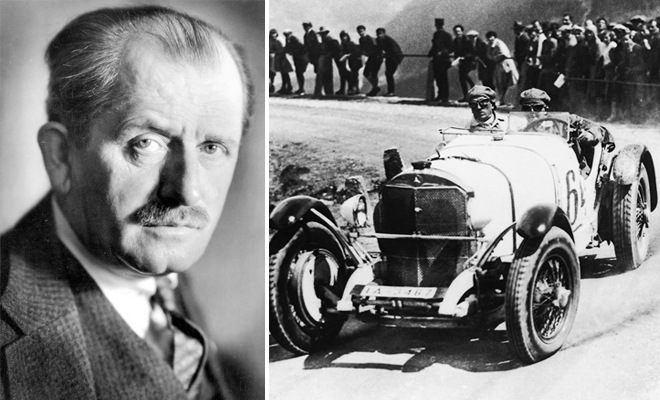
Mercedes Benz SSK (1928)
Designed by Ferdinand Porsche
Designed by Ferdinand Porsche, arguably the most talented automotive engineer of the 20th century, the SSK, short for Super Sport Kurz, broke ground in a number of technical areas including horsepower, a cutting edge transmission and top speed (120 mph). The SSK was the last car that Herr Porsche designed for Mercedes Benz before moving on and starting the Porsche Company. The car is a testament to his engineering and design genius.
Unfortunately, his creations were used for darker purposes as well. A devoted member of the Nazi party, Ferdinand’s later contributions to the mechanical world, including the Volkswagen Beetle and Panzerjager Tiger Tank, were made to expand the power and influence of Nazi ideology. Despite his loyalties, his engineering and design ability have been recognized repeatedly and culminated with the posthumous award of Car Engineer of the Century.
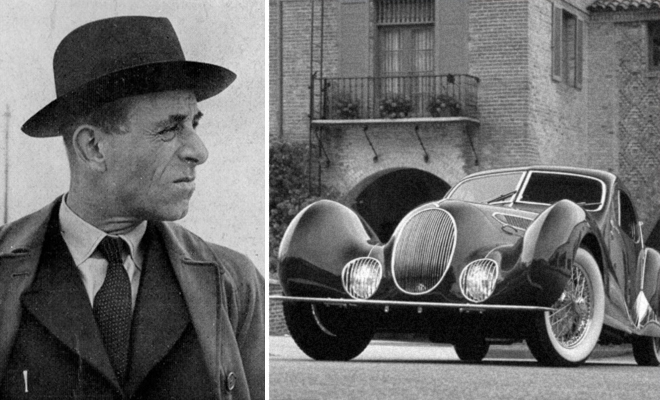
Talbot-Lago T150 CSS (1937)
Designed by Giuseppe Figoni
An iconic body shape and impressive racing chops, clearly mark the T150 as a groundbreaking car. In the 30s, cars were built on a bespoke basis, and the T150 is an ideal example of the benefits of a bespoke approach. The Lago is not only a beautiful car, but one with legitimate racing ability, placing third in the 1938 24 Hours of Le Mans.
Giuseppe Figoni, an Italian born French immigrant, was a talented engineer, as shown by his patented designs for disappearing soft tops and a sunroof. But he’s probably best known for perfecting the teardrop body style of the Lago, a trademark of the French automotive renaissance of the 30s. A true automotive artist, Figoni was inspired by the burgeoning aviation industry and high fashion designers and he would often coordinate the designs of Paris fashion houses with the color of his cars at auto shows.
Since cars were designed on a custom basis, Figoni a more avant-garde approach, something that naturally came with greater risks. He perfected sweeping fenders and aerodynamic curves to produce not only a beautiful car, but a functional one. Figoni was at his best as an automotive sculptor and designer of ostentatious bodywork.
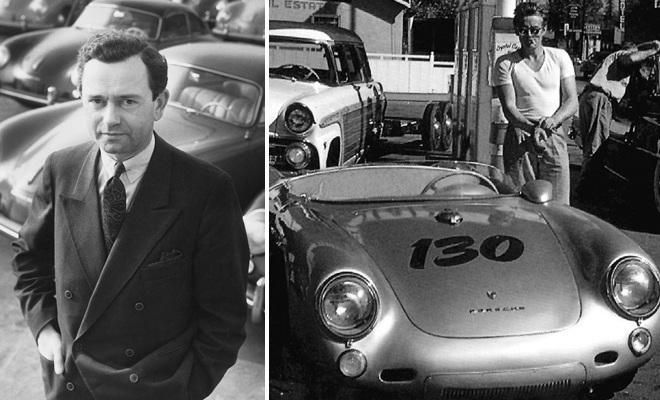
Porsche 550 Spyder (1955)
Inspired by Ferry Porsche
Inspired by the work and design philosophy of Ferry Porsche, son of founder Ferdinand Porsche, and designed by Wilhelm Hild. The 550 was originally built to compete for Porsche in the roadster racing class. 43 Spyders were built as non-racers, one of which was purchased by James Dean, which is also the one he was driving and he met his tragic end.
An engineering leap, the 550 combined a mid-engine layout, ladder framed chassis, and independent body with an extremely low profile and flaring fenders for optimal aerodynamics. It’s a true collector’s item, and highly sought, meaning when sales happen, they’re not cheap. Jerry Seinfeld sold his 1955 Spyder for $5.35 million in March of this year.
Ferry Porsche oversaw the growth of the Porsche Company from a small-bespoke racing outfit to an automotive titan. A renowned designer, Ferry was also a talented negotiator, political scientist, and businessman. It was the combination of these talents that aided Ferry in guiding the Porsche Company from near ruin in post war Germany to one of the most prestigious companies in the world.
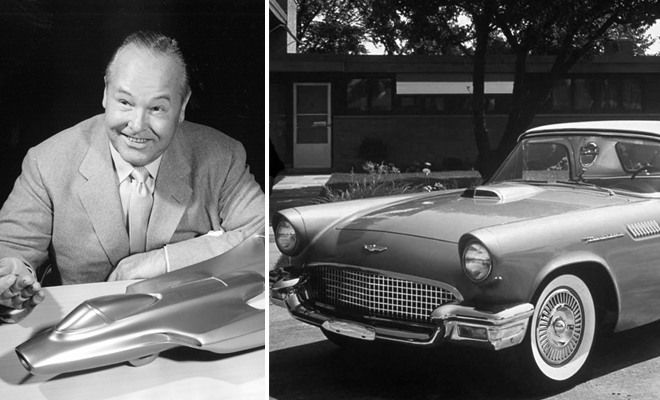
Ford Thunderbird (1955)
Designed by William Boyer
Conceived by George Walker (pictured above) and designed by William P. Boyer, the Thunderbird created a new “personal luxury” class of car (essentially a luxury car with a sports car soul). Boyer expertly combined sleek design cues like a simulated air scoop and engine turned dashboard with standard Ford design elements including stubby tailfins and egg-crate grills. The car was different enough to capture the imagination of Americans and helped to transition American car design from passenger toting boxes to envy inspiring machines.
A company man in every sense of the word, Boyer spent his entire career at Ford and worked on various Ford vehicles including the Mark III, IV, and later iterations of the Thunderbird. Boyer was eventually promoted to Chief Designer of Australia for Ford.
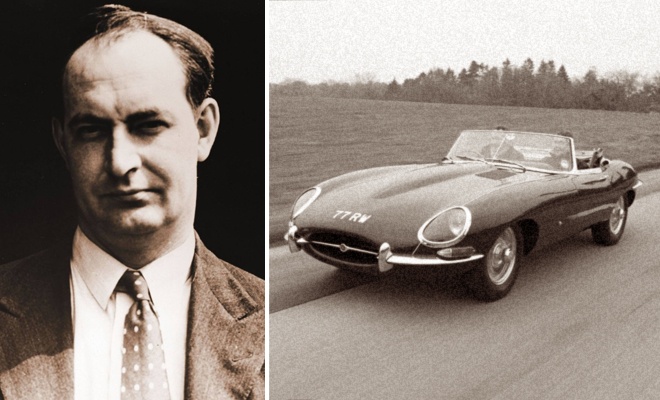
Jaguar E Type (1961)
Designed by Malcolm Sayer
Considered by many to be the most beautiful car of all time, the E-type is a perfect series of contrasts: a long bonnet with a chopped rear, elegant flowing lines with the punch of a bullet, and a delicate look to balance an incredibly powerful engine.
It’s no surprise that the designer, Malcolm Sayer, was a student of aerodynamics and a former employee of the Bristol Aeroplane Company. His principal concerns always centered on making the car as aerodynamic as possible. A designer with a true talent for art (he painted in his spare time), Sayer’s contribution to automotive design and the entire design language of Jaguar have left a lasting impression on the industry. These contributions include the Jaguar C-Type, D-Type, XJ13 and XJS. A final nod to Sayer’s genius, the E-Type is one of only six cars admitted into the Museum of Modern Art.
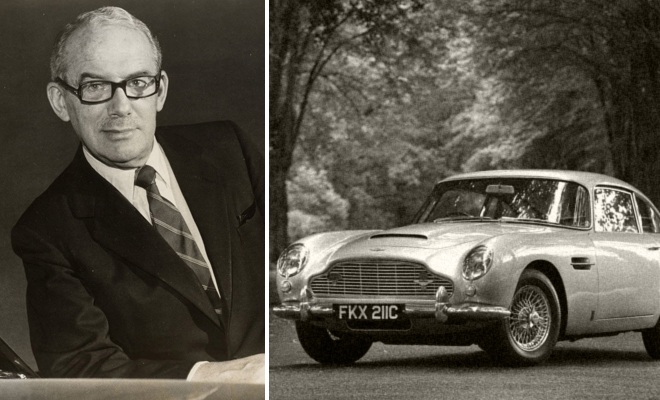
Aston Martin DB5 (1963)
Designed by Harold Beach
Made famous by Sean Connery’s Bond in the movie Goldfinger. For the last 50 years, the DB5 has been regarded as a pop-culture icon. Ironically, from a design standpoint, the DB5 is essentially a DB4 with a more powerful engine, yet stands as the pinnacle of British 1960s car design (DB stands for David Brown the then owner of Aston Martin). Elements like the hood scoop; wing-side vents (an Aston Martin style marker) and spoke wheels legitimize this grand tourer as the icon that pop culture has made it.
The designer, Harold Beach, worked for Aston Martin for three decades, eventually becoming Chief Designer, Engineer and Technical Director. He directly oversaw the design of some of Aston Martin’s most iconic cars including the DB4, the DB5, and the DB6.
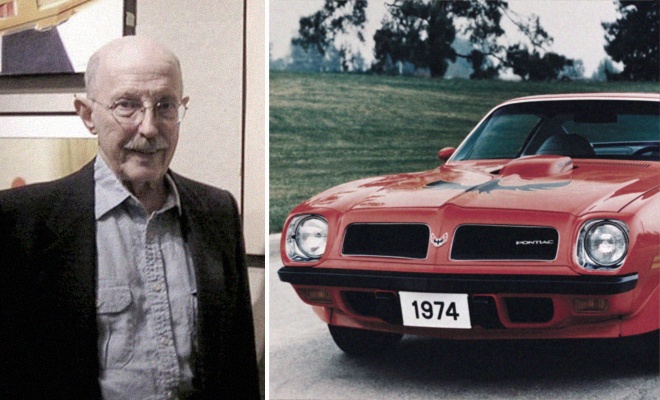
Pontiac Firebird Trans-Am (1970)
Designed by Bill Porter
Execs at GM decided Pontiac needed a car to match the Ford Mustang and rushed a new car, the Firebird, into production. It took several years and a redesign for the Trans-Am to be perfected, but it became a worthy entry with the 1970 model. The Firebird created household American design elements like the double-scooped hood, honeycomb wheel, and of course, the screaming eagle badge. Sadly, it didn’t last long, since the 1970’s were the beginning of the end for the American Muscle Car. The economy was stagnating while insurance premiums and gas prices were increasing, and people simply weren’t buying them like they used to.
Designed by Bill Porter, the Trans Am was actually the second iconic muscle car of Mr. Porter’s career (the first being the 1968 Pontiac GTO). These two cars mark Bill Porter as one of the most important American muscle car designers.
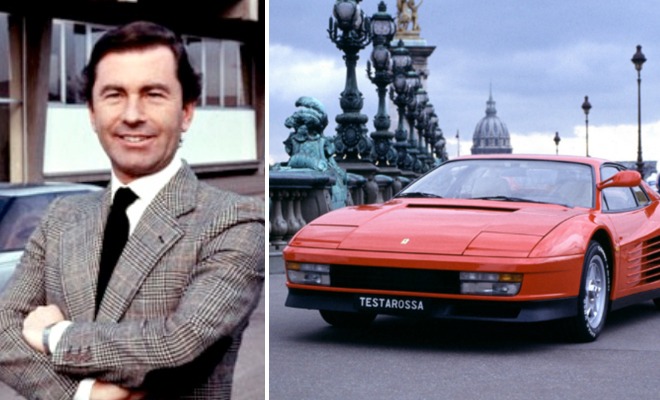
Ferrari Testarossa (1984)
Designed by Design House Pininfarina
Introduced to the world at the 1985 Paris Auto Show, the Testarossa was immediately hailed as a design classic. The Testarossa was designed by the Italian design house Pininfarina and was the first Ferrari to be given a proper name since the Ferrari racing cars of the 1960s. The design team consisted of several designers including Ian Cameron, Guido Campoli, Diego Ottina, Emanuele Nicosia and Chief Designer Leonardo Fiorvanti (pictured above).
Similar to most Ferraris, the Testarossa is a magnificent example of brash, but functional style choices. The side intakes were a remarkable piece of engineering that kept the car from overheating. Because the intakes had to be large in order to receive the proper amount of cooling air, a safety cover had to be developed and the iconic strakes running the length of the car were created. The car was so aerodynamic a rear spoiler wasn’t needed. A brilliant example of both Italian and 1980s design, the Testarossa mixes aggressive style with advanced engineering producing a car both emblematic of the brand and time period.
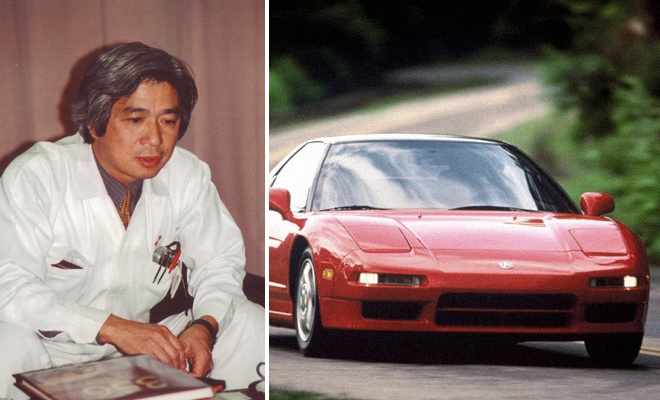
Acura NSX (1990)
Designed by Masachito Nakan and Shigeru Uehara
The NSX was created with three goals in mind: to be more reliable, better performing, and less expensive than competing exotic/GT cars. Chief designer Masachito Nakan and Executive Chief Engineer Shigeru Uehara (pictured above) were tasked with creating a supercar for the people. It was to be an exotic daily driver that accounted for needs like comfort and visibility.
Despite the need for practical comforts, the NSX team was still hyper-focused on handling and performance. The F-16 was one of the chief design inspirations for the car and it mimicked elements of a fighter plane. It has a cab forward layout, long stability enhancing body, and tail wing-mimicking spoiler. The NSX was also the first all aluminum production car (saving substantial amounts of performance sapping weight). The genius of the NSX was that it combined the comfort of a tourer with the performance of a GT car,Thanks to a combination of technological advances and superior design choices.
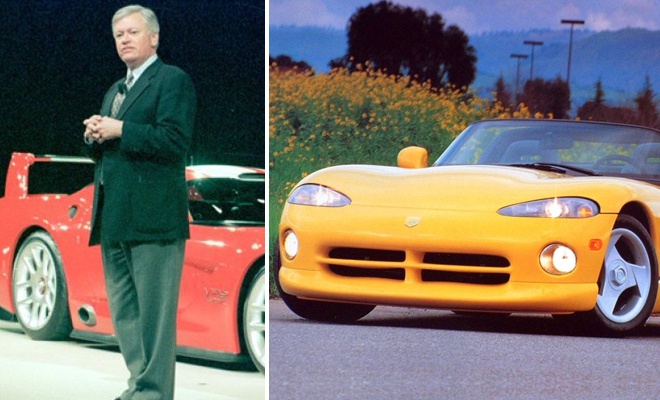
Dodge Viper (1992)
Designed by Tom Gale
With the Viper, Dodge and their Chief of Design, Tom Gale, created a car that was both a reimagining of the past and a provocative middle finger to the establishment. In an era of single form vehicles, the viper looked to the classic Jaguars and Shelby Cobra’s of the 60s for multi form design inspiration. It was designed around one of Mr. Gale’s lasting contributions to Chrysler, the return to rear wheel drive platform.
The Viper was created to showcase its power. A rear wheel drive V-10 beast, the car was designed to be as simple and fast as possible. This was especially clear when the car was originally marketed without a fixed roof, exterior door handles, or side windows. A car created by and specifically for motorheads, the viper is a unique example of a production vehicle created for a niche market, instead of broad appeal. Tom Gale was able to bring one of his many forward thinking concepts to market, and leave a lasting impression on one of the largest car companies in the world.

